
Cosmos: sowing and planting
Contents
The Cosmos in a Nutshell
- Cosmos is an annual flower, sometimes perennial, with tireless flowering from June until the first frosts
- For 6 months, it displays large pristine flowers carried by airy and elegant foliage
- Pure white, claret, pink, yellow or violet, the flowers offer tender, fresh or sunny shades
- Highly floriferous while requiring little care, it’s the perfect young plant for beginners – nearly impossible to fail with!
- It’s equally spectacular in sunny borders, bouquets or containers!
Our expert's word
In the family of daisies (the Asteraceae), Cosmos are undoubtedly among the easiest annuals to grow! From June onwards, these timelessly charming Cosmos rise up and only disappear with the first frosts.
Beneath their simple and naive appearance, cosmos flowers symbolise innocence!
This plant, with its airy foliage and single or double edible flowers in every shade from white to deep burgundy, comes in a wide range of sizes and genus.
From Cosmos bipinnatus to Cosmos atrosanguineum or “chocolate cosmos”, whose flowers emit a cocoa-like fragrance, all are highly floriferous and produce an abundance of flowering for 6 months, lasting into autumn.
With their delicate silhouette, they are perfect for quickly brightening up an empty corner of the garden and filling gaps between still-sparse perennials.
Their slightly vintage or sunny hues are particularly well-suited to romantic gardens and English-style gardens, in flower meadows or even to liven up a slightly dull border.
This annual is easy to grow throughout France, even in dry soil.
Discover our unique collection of Cosmos annuals as plug plants and Cosmos seeds – this graceful flower will make a striking impact in sunny borders as well as in bouquets!
Description and botany
Botanical data
- Latin name Cosmos
- Family Asteraceae
- Common name Cosmos
- Flowering From May-June to November
- Height 0.30 to 1.80 m
- Exposure Sun, partial shade
- Soil type All types, well-drained
- Hardiness tender
The Cosmos is an annual or perennial plant native to the meadows and thickets of the southern United States and Mexico belonging to the Asteraceae family, like daisies, dahlias and asters.
The genus comprises about 25 species, but only three are cultivated in our gardens. Often considered an annual, the Cosmos is actually a tender perennial plant. Cosmos are classified into two main varieties: Cosmos Bipinnatus or bipinnate cosmos which are the most common, with large single white, pink or red flowers, and Cosmos Sulphureus with smaller flowers in warm yellow-orange hues.
Both have given rise to numerous cultivars such as ‘Picotée’ or ‘Cosmic Yellow’ and to interesting strains like ‘Sonata’, a group of dwarf cultivars with very compact growth, ‘Sensation’ which includes giant cultivars, ‘Lady bird’ with its feathery-leaved cultivars, or the ‘Double Click’ group which brings together double or semi-double flowered varieties.
One may also occasionally encounter Cosmos atrosanguineum or “chocolate cosmos”, which is a tuberous perennial species whose flowers emit a cocoa fragrance.
The Cosmos quickly forms a dense, upright to spreading clump with a very bushy, branched habit. Depending on the variety, height ranges from 30 cm for semi-dwarf cosmos, up to 1.80 m for giant cosmos.
The sturdy stems are covered with elegant, delicate foliage, as finely cut as that of a fern, dill or fennel. The deciduous leaves, measuring from 7 to 30 cm, are arranged in opposite pairs, simple, pinnatisect in Bipinnatus and Sulphureus cosmos or pinnate in Cosmos atrosanguineus.
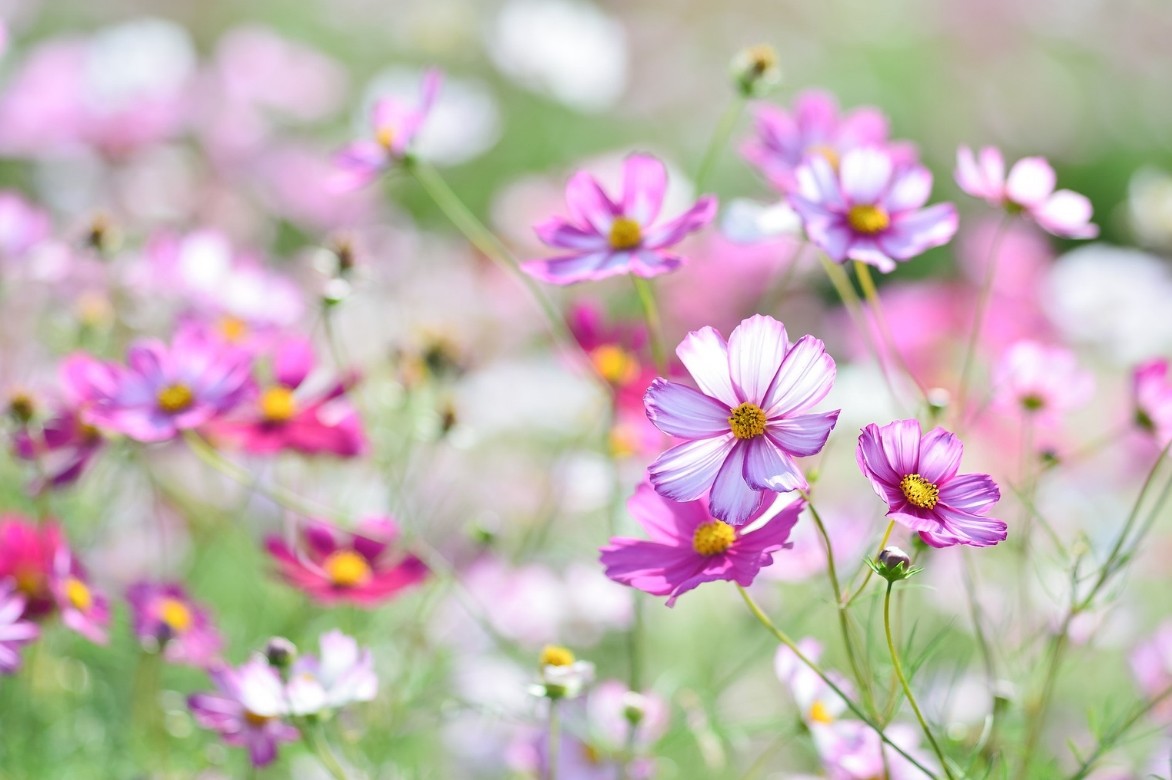
Ranging from light green to dark green, the foliage is often slightly fragrant when crushed. The cultivars in the ‘Lady bird’ series feature feathery foliage.
From May to November, the Cosmos abundantly offers candid flowers of wonderful simplicity and delicacy that seem to float above a beautiful clump of airy foliage. In Greek, “Kosmos” means ornament, an allusion to these flowers of timeless grace.
Perched in numbers at the ends of finely branched stems, the large solitary heads measuring from 2 to 9 cm in diameter appear in wide cups. They consist of round or ovate petals delicately fringed with teeth at the tip, gathered in a single, double or semi-double crown radiating around a golden yellow or black-brown centre. The diaphanous petals with a velvety texture are slightly plicate.
The shape of the ligules varies according to the cultivars, giving the flowers alternately simple or more fanciful appearances.
Some varieties are characterised by very double flowers in delicate pompons, others like the Cosmos ‘Sea shell’ of the Shell type have astonishing flowers composed of quilled and undulate petals which give the flower a rather extravagant look.
Cosmos flowers come in romantic pastel tones or more vibrant, sunnier colours depending on the species: pure white, pale yellow, pink, purple or crimson in Cosmos bipinnatus and its cultivars, ranging from lemon yellow to scarlet red, through orange in Cosmos sulphureus and its cultivars.


Cosmos vary in shape and colour: Cosmos bipinnatus ‘Rose Bonbon’, Cosmos bipinnatus ‘Picotee’ (©Horticolor), Cosmos atrosanguineus ‘Chocamoca’, Cosmos bipinnatus ‘Xanthos’, Cosmos sulphureus ‘Cosmic Orange’
These corollas are often bicoloured, regularly striped and edged with darker shades.
While Cosmos flowers are usually unscented, those of Cosmos atrosanguineus emit delicious chocolate-vanilla aromas.
Its flowers make up chic, fresh or rustic bouquets and hold very well in vases.
Another attraction is that Cosmos flowers are edible and have a subtle floral flavour ideal for enhancing salads, decorating cakes as well as sorbets and ice creams in summer!
This exceptionally generous flowering, particularly melliferous, attracts numerous insects and butterflies all summer long.
This annual is tireless, it flowers for over six months of the year: the light and poetic flowering is continuous, only ceasing with the first frosts.
In the past, a pigment used to dye textiles yellow-orange was extracted from the flowers of Cosmos sulphureus.
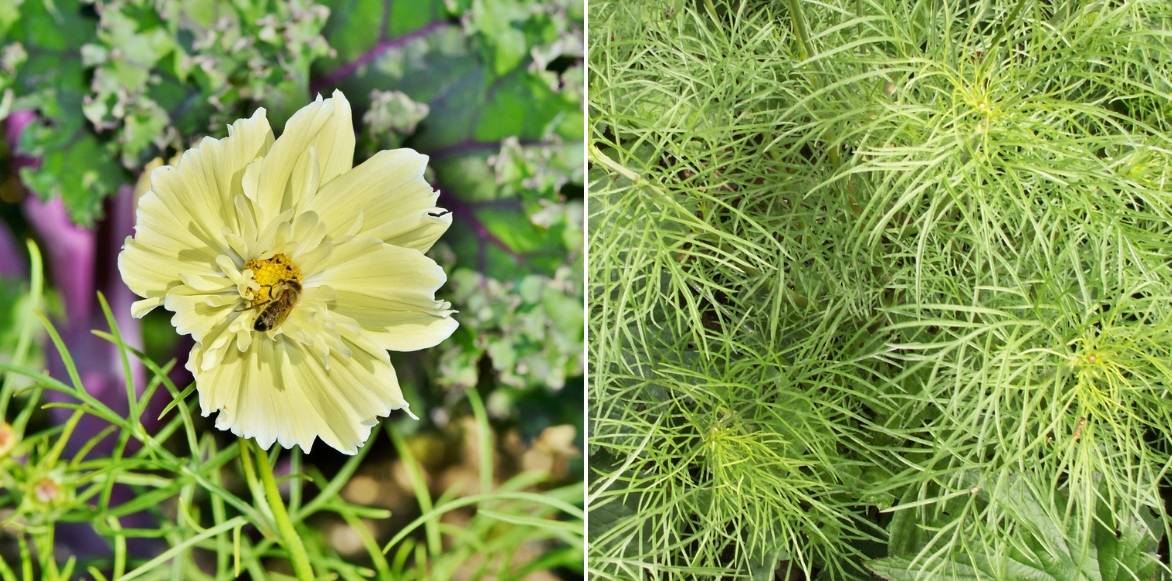
The flowers are very popular with pollinators and the foliage is particularly decorative
The flowers are followed by the formation of bristly blackish fruits, much appreciated by birds. Cosmos seeds self-seed easily from year to year in the soil.
The Cosmos is a non-hardy perennial plant that is grown as an annual in all our regions. It is planted or sown in the sun in any good garden soil that is not too rich, even poor and dry.
The Cosmos is perfect for adding colour and cheer to the garden throughout the fine season with minimal maintenance. Indispensable in rustic settings, in natural gardens and romantic ones, it brings lightness and poetry.
It fits everywhere in summer perennial borders, to flower the vegetable garden or a wild meadow, dry rockeries, edges and even containers or pots on the terrace or balcony.
Read also
Planting AnnualsMain species and varieties
While the genus includes 25 species of annuals and perennials, only three are commonly found in our gardens; the Cosmos bipinnatus or bipinnate cosmos with pink, white or carmine flowers that can reach up to 1.8m tall, the Cosmos sulphureus, with a lighter appearance and mainly orange flowers, and the Cosmos atrosanguineum, the “Chocolate Cosmos” with its cocoa fragrance, a slightly tender perennial.
The first two, grown as annuals, have given rise to many interesting series such as the ‘Sensation’ series, featuring giant cosmos in white or pink reaching up to 1m tall, and the ‘Sonata’ series, with semi-dwarf cultivars that stay under 60cm tall and are perfect for container growing.
The single or double flowers, depending on the cultivar, come in a wide range of colours, from pastels to the most vibrant crimson reds or oranges, from pure tones to subtle bicolours.
As plug plants or seeds, browse our unique collection of annual Cosmos.
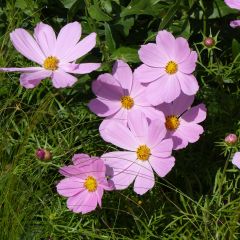
Cosmos bipinnatus Sonata Light Pink
- Flowering time July to November
- Height at maturity 50 cm
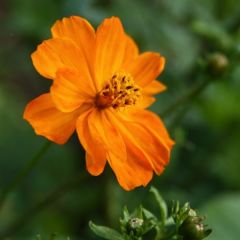
Cosmos sulphureus Mandarin
- Flowering time July to December
- Height at maturity 30 cm

Cosmos Sensation Purity Seeds - Cosmos bipinnatus
- Flowering time July to November
- Height at maturity 1,20 m
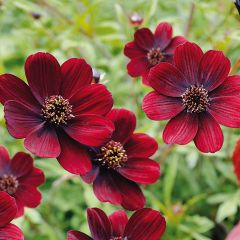
Cosmos atrosanguineus Chocamocha
- Flowering time July to November
- Height at maturity 40 cm

Cosmos bipinnatus Cosmos Double Click Mixed
- Flowering time July to November
- Height at maturity 95 cm

Cosmos Sonata Carmin - Garden Cosmos
- Flowering time July to November
- Height at maturity 60 cm

Cosmos sulphureus Polidor - Sulfur Cosmos
- Flowering time July to November
- Height at maturity 75 cm

Cosmos Velouette Seeds - Cosmos bipinnatus
- Flowering time July to November
- Height at maturity 85 cm

Cosmos Sensation Picotee - Cosmos bipinnatus seeds
- Flowering time August to October
- Height at maturity 90 cm
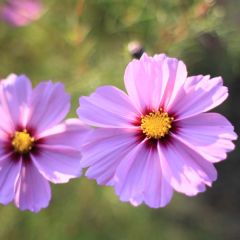
Cosmos Sensation Radiance - Cosmos bipinnatus seeds
- Flowering time August to October
- Height at maturity 90 cm
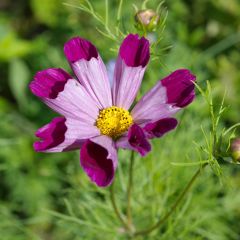
Cosmos Pied Piper Red Seeds - Cosmos bipinnatus
- Flowering time July to November
- Height at maturity 75 cm
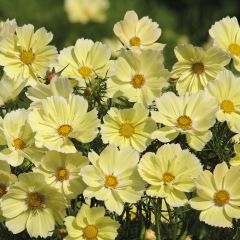
Cosmos Xanthos Seeds - Cosmos bipinnatus
- Flowering time July to November
- Height at maturity 60 cm
Discover other Cosmos seeds
View all →Available in 1 sizes
Available in 1 sizes
Available in 1 sizes
Available in 1 sizes
Available in 1 sizes
Available in 1 sizes
Available in 1 sizes
Available in 1 sizes
Available in 1 sizes
Available in 1 sizes
When and how to plant cosmos
Where to Plant Cosmos?
From its South American origins, Cosmos has retained a strong sensitivity to cold. It is a tender perennial that only withstands light frosts. At the first frost, cosmos dies. This is why, in our climate, it is most often grown as an annual in the garden.
One exception, however: the chocolate cosmos, which is cultivated like a Dahlia – lift the tubers before frost and store them in a cool place.
The fragility of Cosmos is only superficial! This non-hardy annual is very easy to grow throughout France and is drought-resistant once established. To flower well, cosmos needs a sunny position.
Undemanding when it comes to soil, it is highly adaptable and will thrive in any well-drained soil that remains cool during summer, showing a preference for poor, sandy, or even stony soils. It will even flower in dry soil and self-seeds easily without becoming invasive.
Cosmos atrosanguineus prefers lighter, more humus-bearing and moist soil.
The tallest varieties, with their delicate silhouettes, may bend under harsh weather. It’s best to shelter them from prevailing winds or stake them in overly windy spots. Grouping plants together can help them support each other. Smaller cosmos varieties cope better in windy locations.
Versatile, cosmos is perfectly suited to small gardens as well as large flower-filled prairies.
The endless flowering of Cosmos, from May until the first frosts, makes it an excellent choice for quickly brightening up sunny borders, flower beds, or even pots and containers. It’s ideal for filling gaps among sparse perennials.
Semi-dwarf varieties, being particularly compact, fit anywhere—in borders, rockeries, among perennials, and even in window boxes.
Taller cultivars create vibrant backdrops for borders, planted in the second or third row of a flower bed, or used to adorn a wall or a small temporary wild hedge.
Cosmos also has a place in the vegetable garden, as it works well as a cut flower.
When to Plant Cosmos?
Plant Cosmos in spring, from April to June, once the risk of frost has passed and the soil has warmed up, for flowering from June to October.
How to Plant Cosmos as Plug Plants?
In the ground
Upon arrival, pot up and keep our annual Cosmos plug plants under cover at a temperature above 14°C for a few weeks. Once the risk of frost has passed, plant them out in the garden or move pots into full sun.
Plant approximately 4 to 9 plants per m², spaced 40 to 50 cm apart for tall cosmos and 20 to 30 cm for shorter varieties, to achieve a dense, abundant effect.
The soil should be moderately fertile but well-drained. Refer to our guide on planting annual plug plants.
- Loosen the soil to the depth of a spade
- Dig a hole three times wider than the plug
- Add a layer of gravel beneath each plug in the planting hole
- Plant in slightly sandy garden soil
- Position the plug in the centre, with the collar level with the soil
- Backfill with soil
- Firm gently with your foot
- Water and mulch
- Stake taller varieties if needed
In pots
Compact varieties of Cosmos are well-suited to container growing. Plant one or two per 50 cm diameter pot, depending on the variety.
- Add a thick layer of drainage (gravel or clay pebbles) to the base
- Plant in a mix of garden soil and sand
- Place in full sun
- Water regularly for prolonged flowering
→ Learn more in our article Growing Cosmos in Pots.
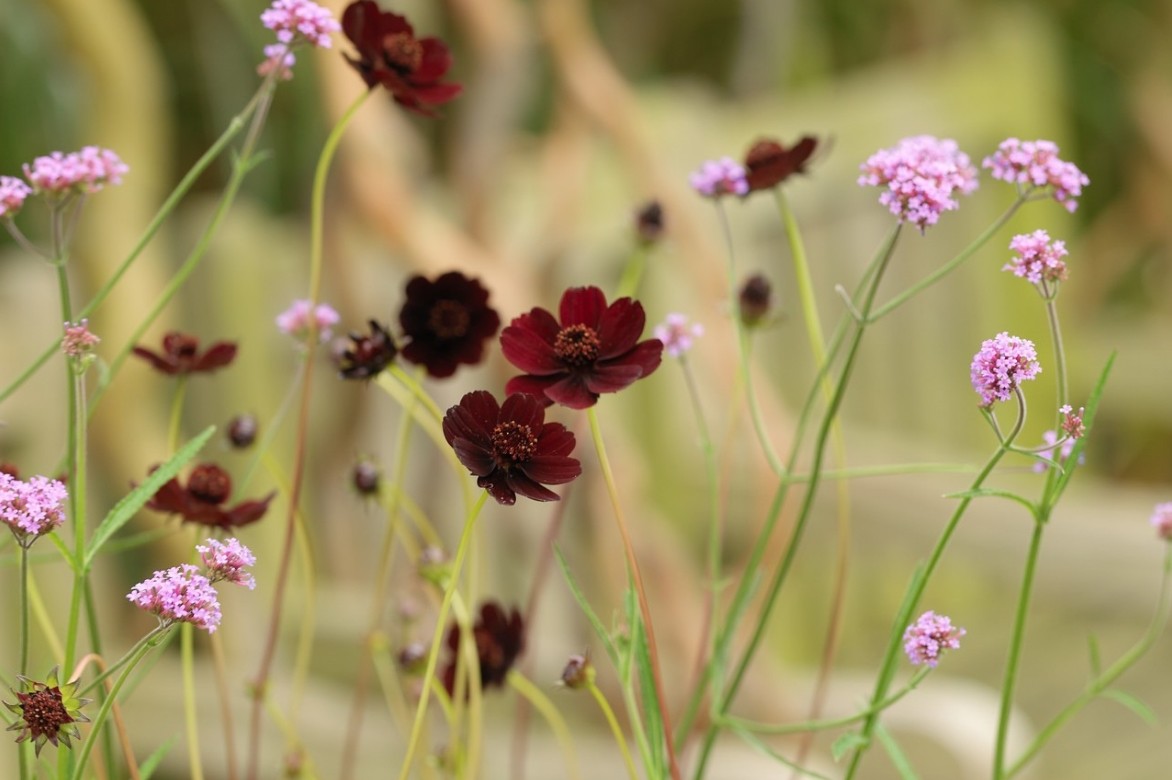
The famous Chocolate Cosmos alongside Buenos Aires Verbena – photo Ibulb
Sowing Cosmos seeds
You should expect between 80 and 90 days from sowing to flowering for Cosmos. Cosmos seeds sown at the very beginning of spring will bloom until late in the season.
Sowing under cover
- In March-April, sow 1 or 2 Cosmos seeds in a seed tray at a depth of 3mm in light compost
- Cover the seeds lightly
- Place at a temperature of 18-25°C
- Keep the soil moist until germination
- Keep only the strongest seedlings and transplant into buckets
- Once all risk of frost has passed, gradually acclimatise the young plants to outdoor conditions
- Plant out permanently after the last frosts in the garden, spacing plants 30 to 45cm apart, or in containers
- Pinch out the tip of each stem to encourage branching
Direct sowing in situ
Sow Cosmos seeds in May after the last frosts in ordinary garden soil mixed with compost. Be careful, the seeds are quite fine: sow broadcast for a natural look. Discover all our tips for sowing annual seeds successfully.
- Dig the soil well
- Add river sand to lighten it if needed
- Sow broadcast
- Cover the seeds with a rake
- Water regularly until germination
- When the seedlings reach 10cm, thin out to leave just one young plant spaced 20 to 45cm apart in all directions, depending on the variety
Maintenance, Pruning and Care
The Cosmos is a short-lived perennial that’s truly very easy to grow and undemanding. Once established in full sun and well-drained soil, it grows effortlessly.
To prolong flowering, regularly remove spent flowers. Pinching back stems also encourages the plant to become more ramified and produce more flowers.
Although it tolerates short dry spells quite well, cosmos prefers soils that remain moist: as soon as dry weather sets in, water regularly.
You can mulch to ensure sufficient moisture around the base during summer.
It requires no fertiliser.
In very windy locations, tall cosmos may need staking to prevent them from being blown over.
Lift the clumps at the onset of winter.
In colder regions, before frost arrives, dig up the tubercles of Cosmos atrosanguineus or “chocolate cosmos” and overwinter them in pots in a cool, frost-free place.
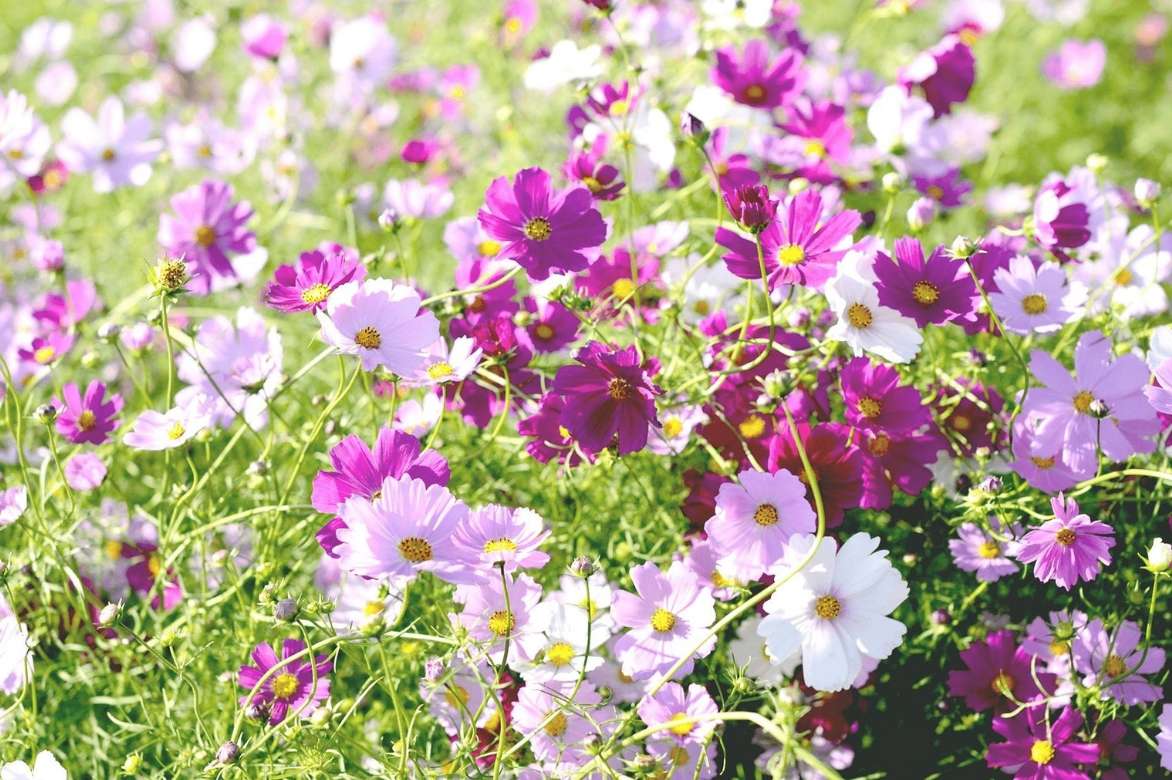
Diseases and potential pests
When raising seedlings, it’s wise to protect the young shoots of cosmos from the appetite of slugs and snails: discover our 7 ways to effectively and naturally combat slugs and how to make a slug trap.
The young plants may be infested with aphids: spray with water mixed with 5% black soap.
Cosmos is also susceptible to powdery mildew. If affected, follow our advice for combating powdery mildew.
More troublesome, Cosmos can be prone to botrytis disease (grey mould) which attacks the roots. Avoid overly heavy and compact soil that retains moisture.
Propagation
You can harvest the seeds before they disperse and follow our advice for successful sowing of cosmos seeds. However, cosmos usually self-seed spontaneously from one year to the next. These volunteer seedlings aren’t always true to type. The “Chocolate Cosmos” can be propagated by dividing the tubercles in autumn.
Pairing Cosmos in the Garden
With its airy and elegant silhouette and its single flowers, the Cosmos is ideal in a naturalistic-inspired garden, in cottage gardens, or in country gardens to create wild and romantic scenes with effortless charm. It is a must-have in a pink garden or a white garden.
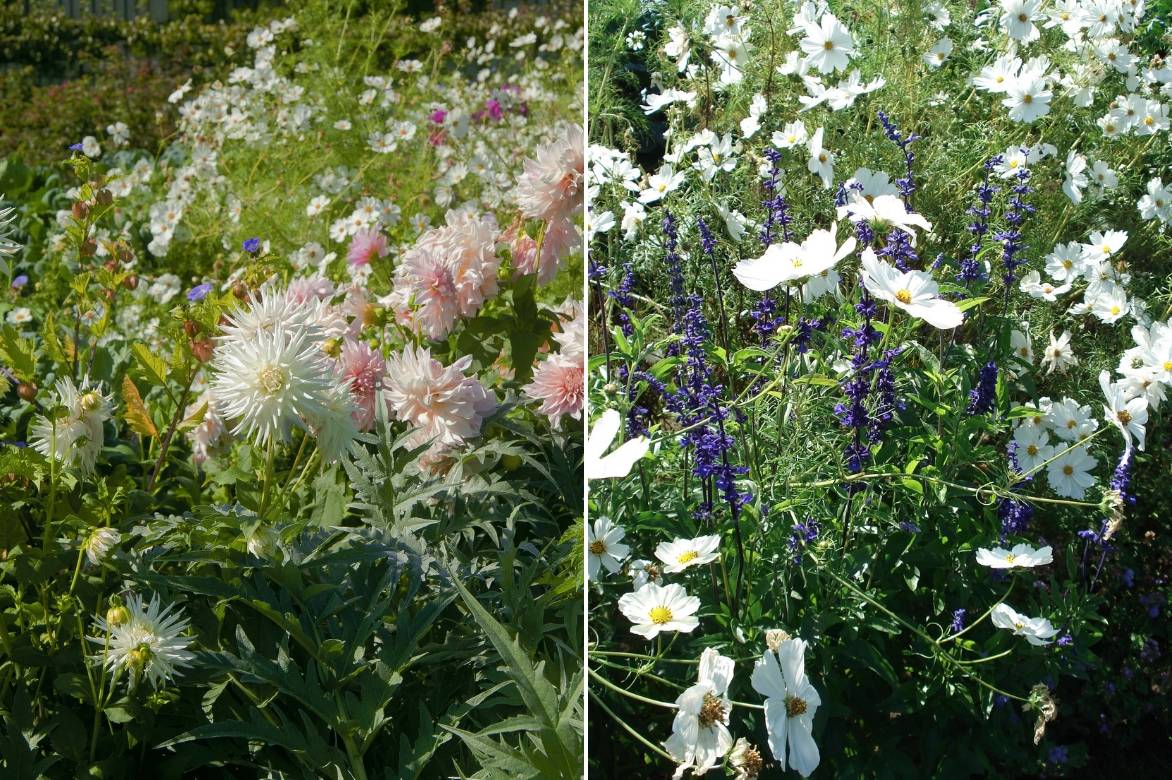

An example of companion planting: Cosmos Sonata White, Giant Dahlia ‘Café au Lait’, Cactus Dahlia ‘My Love’, Cynara cardunculus, Salvia farinacea ‘Victoria’
Capable of filling a flowerbed on its own, Cosmos is also easy to pair with many other low-maintenance summer flowers.
Cosmos adds density to flowerbeds and lightness to the heavier flowering of perennials.
To create a sunny naturalistic meadow atmosphere, mix Cosmos with yarrow, poppies, large-flowered poppies, annual grasses like foxtail barley, cornflowers, delphiniums, or even Love-in-a-Mist, flaxes, and Scabious.
This plant adds density to flowerbeds and lightness to the heavier flowering of some summer perennials like sunflowers, heleniums, or cannas.


Another example of companion planting: Cosmos bipinnatus ‘Purity’, Salvia farinacea ‘Blue Plus’, Zinnia elegans ‘Purple Prince’, Pompon Dahlia ‘Red Fox’, White Mustard (©MAP Arnaud Descat – Jardin de Saint-Jean-de-Beauregard)
The long flowering period of Cosmos allows it to accompany many other flowers from spring to autumn, such as Alchemilla mollis, roses in June or September, and clumps of Perovskia.
To liven up a flowerbed that’s a bit too flat and tame, pair Cosmos with tall, airy plants like gas plants, Verbena bonariensis, Gauras, Crocosmias, and other sun-loving daisies like Echinaceas.
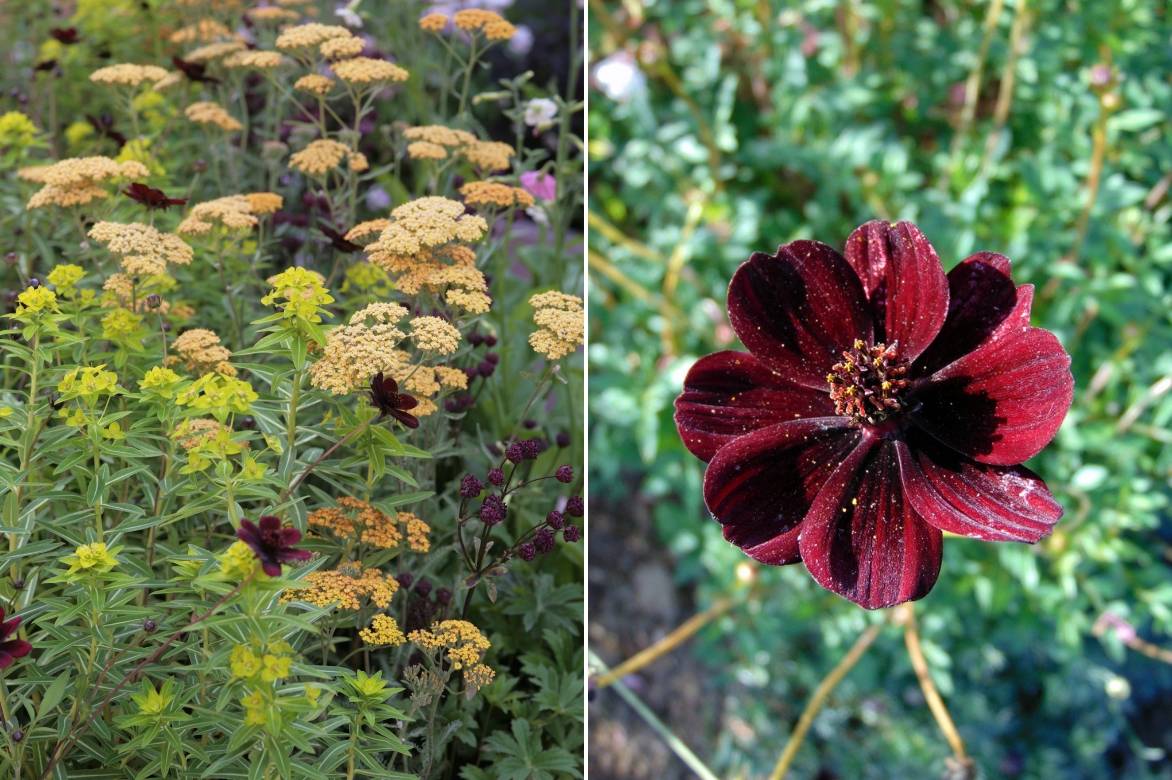

A planting idea: Spurge (E. wallichii, E. martinii, or your preferred variety), Masterwort (‘Ruby Wedding’, ‘Ruby Star’, ‘Lars’…), Cosmos atrosanguineus, Achillea millefolium ‘Terracotta’
Play with contrasting shapes by adding grasses like Stipa tenuifolia or Pennisetum.
In a sunny border with vibrant colours, mix small Cosmos with annual rudbeckias. All Cosmos have a somewhat bare base and benefit from being planted behind lower-growing plants like dianthus, hardy geraniums, or sages.
In a summer pink flowerbed, combine Cosmos with dwarf dahlias, summer-flowering bushes like buddleias and annual lavateras. Soften the look with a large clump of airy artemisia for guaranteed blooms all summer!
You can also pair it with other annuals like Coreopsis, Cleomes, and Bidens for a vibrant, colourful display.
→ Discover 6 more beautiful Cosmos companion planting ideas in our guide!
Useful resources
- Cosmos are the perfect plants to create a romantic atmosphere in your garden in just one season
- Discover all our annual flowers
- Which other annuals to pair with your cosmos: find all the ideas on our blog!
- Check out our tutorial: How to sow cosmos?
Frequently asked questions
-
Do cosmos regrow?
Cosmos are tender perennial plants. In our gardens, they die at the first sign of frost. However, self-sowing is common in light, dry, well-drained soil. It is therefore quite possible to see cosmos flower again from one year to the next in unexpected places, though often in colours that differ from the parent plant.
- Subscribe!
- Contents
.](https://en.promessedefleurs.eu/blogwp/wp-content/uploads/2018/12/cosmos-tout-savoir.jpg)




































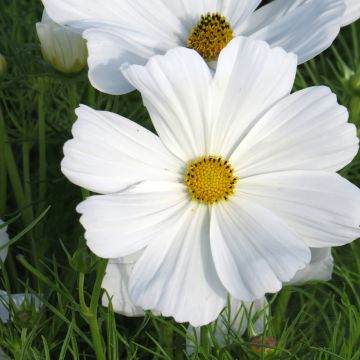
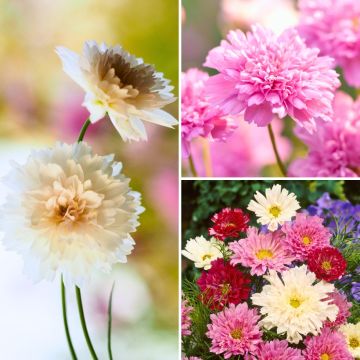

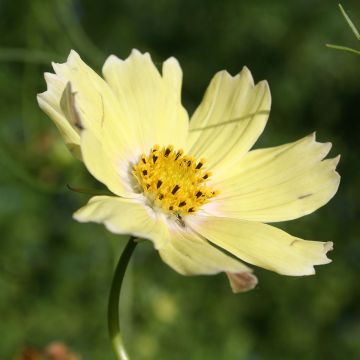




Comments